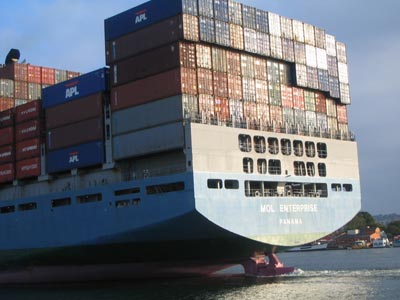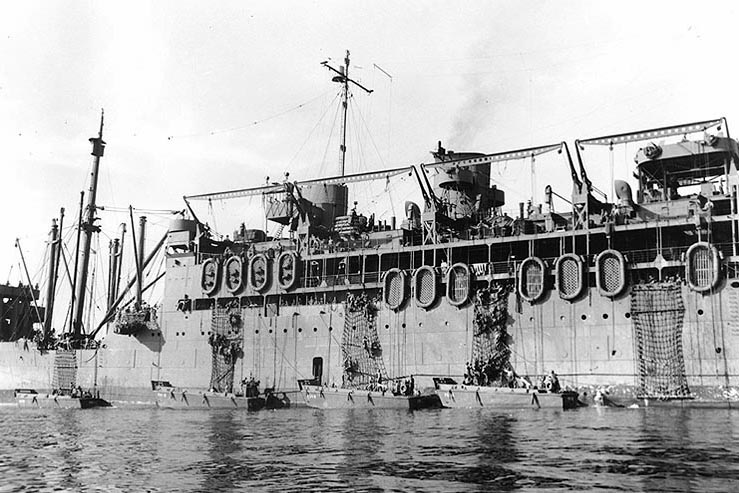|
SS Takao Maru (1927)
was an OSK Line cargo and passenger steamship that was built in Japan in 1927. In 1941 the Imperial Japanese Army requisitioned her. US aircraft damaged her during the first week of the Japanese invasion of the Philippines. In 1942 she was declared a total loss. Building and registration The Uraga Dock Company in Uraga, Kanagawa built ''Takao Maru'' as yard number 317. She was laid down on 19 July 1926, launched on 2 April 1927, and completed that May. ''Takao Maru''s registered length was , her beam was , her depth was and her draft was . Her tonnages were and . She had berths for 70 passengers: six in first class, and 64 in third class. ''Takao Maru'' had a single screw, driven by two Mitsubishi steam turbines via double-reduction gearing. Their combined power output was rated at 782 NHP or 3,915 shp, and gave her a speed of . She was designed as a high-speed banana ship, and had an advanced mechanical ventilation system to cool her cargo holds. The Yokohama Doc ... [...More Info...] [...Related Items...] OR: [Wikipedia] [Google] [Baidu] |
Osaka Shosen Kaisha
Mitsui O.S.K. Lines (; abbreviated MOL) is a Japanese transport Company (law), company headquartered in Toranomon, Minato, Tokyo, Japan. It is one of the largest shipping companies in the world. Founded as a key part of the Mitsui ''zaibatsu'' (family-owned Conglomerate (company), conglomerate) during the early industrialization of Japan, the company remains part of the Mitsui ''keiretsu'' (group of aligned companies) after the dissolution of the zaibatsu in the post-war period. MOL fleet includes dry cargo ships (bulk carriers), liquefied natural gas carriers, Roll-on/roll-off, Ro-Ro Car Carrier ships, oil Tanker (ship), tankers, Containerization, container ships (among which mv MOL Triumph is the 4th largest containership in the world), and container terminals. The company's container shipping operations were merged with those of Nippon Yusen, NYK Line and K Line and rebranded as Ocean Network Express in April 2018, with MOL holding a 31% stake in the joint venture. MOL is al ... [...More Info...] [...Related Items...] OR: [Wikipedia] [Google] [Baidu] |
Total Loss
In insurance claims, a total loss or write-off is a situation where the lost value, repair cost or salvage cost of a damaged property exceeds its insured value, and simply replacing the old property with a new equivalent is more cost-effective. Such a loss may be an "actual total loss" or a "constructive total loss". Constructive total loss considers further incidental expenses beyond repair, such as ''force majeure''. General principles In a total loss, the insurer must indemnify the assured in full, and ownership of the insured item thereby passes to the insurer under the legal process of "subrogation". Although the policy determines the level at which the loss becomes total rather than partial, nevertheless the assured (and NOT the insurer) has the final say as to whether he wishes to make a partial or total claim. If the insured item is, say, a car or a house, the policy will normally give it a "market value" which may be less than the assured had in mind; any disagre ... [...More Info...] [...Related Items...] OR: [Wikipedia] [Google] [Baidu] |
Troopship
A troopship (also troop ship or troop transport or trooper) is a ship used to carry soldiers, either in peacetime or wartime. Troopships were often drafted from commercial shipping fleets, and were unable to land troops directly on shore, typically loading and unloading at a seaport or onto smaller vessels, either Ship's tender, tenders or barges. Attack transports, a variant of ocean-going troopship adapted to transporting invasion forces ashore, carry their own fleet of landing craft. Landing ships beach themselves and bring their troops directly ashore. History Ships to transport troops were used in antiquity. Ancient Rome used the navis lusoria, a small vessel powered by rowers and sail, to move soldiers on the Rhine and Danube. The modern troopship has as long a history as passenger ships do, as most maritime nations enlisted their support in military operations (either by leasing the vessels or by impressing them into service) when their normal naval forces were deemed ... [...More Info...] [...Related Items...] OR: [Wikipedia] [Google] [Baidu] |
Engine Room
On a ship, the engine room (ER) is the Compartment (ship), compartment where the machinery for marine propulsion is located. The engine room is generally the largest physical compartment of the machinery space. It houses the vessel's prime mover, usually some variations of a heat engine (Marine steam engine, steam engine, diesel engine, Gas turbine, gas or steam turbine). On some ships, there may be more than one engine room, such as forward and aft, or port or starboard engine rooms, or may be simply numbered. To increase a vessel's safety and chances of surviving damage, the machinery necessary for the ship's operation may be segregated into various spaces. The engine room is usually located near the bottom, at the rear or aft end of the vessel, and comprises few compartments. This design maximizes the cargo carrying capacity of the vessel and situates the prime mover close to the propeller, minimizing equipment cost and problems posed from long shaft lines. On some ships, the ... [...More Info...] [...Related Items...] OR: [Wikipedia] [Google] [Baidu] |
Tokyo Bay
is a bay located in the southern Kantō region of Japan spanning the coasts of Tokyo, Kanagawa Prefecture, and Chiba Prefecture, on the southern coast of the island of Honshu. Tokyo Bay is connected to the Pacific Ocean by the Uraga Channel. The Tokyo Bay region is the most populous and the largest industrialized area in Japan. Names In ancient times, the Japanese knew Tokyo Bay as the . By the Azuchi–Momoyama period (1568–1600) the area had become known as after the city of Edo. The bay took its present name in modern times, after the Imperial court moved to Edo and renamed the city Tokyo in 1868. Geography Tokyo Bay juts prominently into the Kantō Plain. It is surrounded by the Bōsō Peninsula in Chiba Prefecture to the east and the Miura Peninsula in Kanagawa Prefecture to the west. The shore of Tokyo Bay consists of a Diluvium, diluvial plateau and is subject to rapid marine erosion. Sediments on the shore of the bay make for a smooth, continuous shoreline. Bound ... [...More Info...] [...Related Items...] OR: [Wikipedia] [Google] [Baidu] |
Kannonzaki Lighthouse
Kannonzaki Lighthouse (観音埼灯台) is a lighthouse on Cape Kannon, on Miura Peninsula, in Yokosuka, Kanagawa, Japan. History The original Kannonzaki Lighthouse was the first lighthouse built in Japan. It was one of the eight lighthouses whose construction was stipulated by the Anglo-Japanese Treaty of Amity and Commerce of 1858. This treaty provided for the development of aids to navigation with the opening of Japanese ports to foreign trade. Modern engineering methods had not been developed in Japan at the time so the Tokugawa Shogunate requested the assistance of the authorities of France and England for the construction of lighthouses and the purchasing of necessary equipment. The Tokugawa Shogunate specifically planned to construct a lighthouse at the mouth of Tokyo Bay for vessels that would leave the Yokosuka Iron Works then under construction. After the fall of the Tokugawa Shogunate The new Meiji government commenced construction of the first lighthouse with Franc ... [...More Info...] [...Related Items...] OR: [Wikipedia] [Google] [Baidu] |
Reefer Ship
A reefer ship is a refrigerated cargo ship typically used to transport perishable cargo, which require air conditioning, temperature-controlled handling, such as fruits, meat, vegetables, dairy products, and similar items. Description ''Types of reefers:'' Reefer ships may be categorised into three types: # Side-door vessels have water-tight ports on the ship's hull, which open into a cargo hold. Elevators or ramps leading from the quay serve as loading and discharging access for the forklifts or conveyors. Inside these access ports or side doors, pallet lifts or another series of conveyors bring the cargo to the respective decks. This special design makes the vessels particularly well suited for inclement weather operations as the tops of the cargo holds are always closed against rain and sun. # Conventional vessels have a traditional cargo operation with top opening hatches and crane (machine), cranes/derrick (lifting device), derricks. On such ships, when facing wet weather, ... [...More Info...] [...Related Items...] OR: [Wikipedia] [Google] [Baidu] |
Ship Registration
Ship registration is the process by which a ship is documented and given the nationality of the country to which the ship has been documented. The nationality allows a ship to travel internationally as it is proof of ownership of the vessel. International law requires that every ship be registered in a country, called its flag state.ICFTU et al., 2002, p. 7. A ship is subject to the law of its flag state. It is usual to say that the ship sails under the flag of the country of registration. A ship's flag state exercises regulatory control over the vessel and is required to inspect it regularly, certify the ship's equipment and crew, and issue safety and pollution prevention documents. The organization which actually registers the ship is known as its registry. Registries may be governmental or private agencies. In some cases, such as the United States' Alternative Compliance Program, the registry can assign a third party to administer inspections. A register that is open only t ... [...More Info...] [...Related Items...] OR: [Wikipedia] [Google] [Baidu] |
Sister Ship
A sister ship is a ship of the same Ship class, class or of virtually identical design to another ship. Such vessels share a nearly identical hull and superstructure layout, similar size, and roughly comparable features and equipment. They often share a common naming theme, either being named after the same type of thing or person (places, constellations, heads of state) or with some kind of alliteration. Typically the ship class is named for the first ship of that class. Often, sisters become more differentiated during their service as their equipment (in the case of naval vessels, their armament) are separately altered. For instance, the U.S. warships , , , and are all sister ships, each being an . Perhaps the most famous sister ships were the White Star Line's s trio, consisting of , and . As with some other liners, the sisters worked as running mates. Of the three sister ships, ''Titanic'' and ''Britannic'' would both sink within a year of being launched, while RMS ''O ... [...More Info...] [...Related Items...] OR: [Wikipedia] [Google] [Baidu] |
Yokohama
is the List of cities in Japan, second-largest city in Japan by population as well as by area, and the country's most populous Municipalities of Japan, municipality. It is the capital and most populous city in Kanagawa Prefecture, with a population of 3.7 million in 2023. It lies on Tokyo Bay, south of Tokyo, in the Kantō region of the main island of Honshu. Yokohama is also the major economic, cultural, and commercial hub of the Greater Tokyo Area along the Keihin region, Keihin Industrial Zone. Yokohama was one of the cities to open for trade with the Western world, West following the 1859 end of the Sakoku, policy of seclusion and has since been known as a cosmopolitan port city, after Kobe opened in 1853. Yokohama is the home of many Japan's firsts in the Meiji (era), Meiji period, including the first foreign trading port and Chinatown (1859), European-style sport venues (1860s), English-language newspaper (1861), confectionery and beer manufacturing (1865), daily newspap ... [...More Info...] [...Related Items...] OR: [Wikipedia] [Google] [Baidu] |
Mitsubishi
The is a group of autonomous Japanese multinational companies in a variety of industries. Founded by Yatarō Iwasaki in 1870, the Mitsubishi Group traces its origins to the Mitsubishi zaibatsu, a unified company that existed from 1870 to 1946. The company, along with other major zaibatsu, was disbanded during the occupation of Japan following World War II by the order of the Allies. Despite the dissolution, the former constituent companies continue to share the Mitsubishi brand and trademark. While the group of companies engages in limited business cooperation, most notably through monthly "Friday Conference" executive meetings, they remain formally independent and are not under common control. The three main entities ('' gosanke'') are Mitsubishi UFJ Financial Group (the largest bank in Japan), Mitsubishi Corporation (a general trading company), and Mitsubishi Heavy Industries (a diversified manufacturing company). A 2020 estimate concluded that all the Mitsubishi compani ... [...More Info...] [...Related Items...] OR: [Wikipedia] [Google] [Baidu] |
Tonnage
Tonnage is a measure of the capacity of a ship, and is commonly used to assess fees on commercial shipping. The term derives from the taxation paid on '' tuns'' or casks of wine. In modern maritime usage, "tonnage" specifically refers to a calculation of the volume or cargo volume of a ship. Although tonnage (volume) should not be confused with displacement (the actual mass of the vessel), the long ton (or imperial ton) of 2,240 lb is derived from the fact that a " tun" of wine typically weighed that much. Current maritime units Tonnage measurements are governed by an IMO Convention (International Convention on Tonnage Measurement of Ships, 1969 (London-Rules)), which initially applied to all ships built after July 1982, and to older ships from July 1994.''Inte ... [...More Info...] [...Related Items...] OR: [Wikipedia] [Google] [Baidu] |








